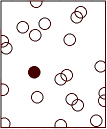Principles of design - Balance
Balance - is a
feeling of visual equality in shape, form, value, color,
etc. Balance can be symmetrical or evenly balanced or asymmetrical and
un-evenly balanced. Objects, values, colors, textures, shapes, forms, etc., can be
used in creating a balance in a composition
In visual images, balance is formal when both sides are symmetrical in terms of
arrangement.
Example of principle design formal balance display photo.
Informal balance is more dynamic than formal balance and normally keeps the learner's attention focused on the visual message.
Example of principle design informal balance (Asymmetrica) display photo.
There are three main types of balance
vertical balance
horizontal balance
radial balance
Design Principles - Harmony
Patterns or shapes can help achieve harmony.
By repeating patterns in an interesting arrangement, the overall visual image comes together.
Harmony pulls the pieces of a visual image together.
Harmony can be achieved through repetition and rhythm.
Repetition reemphasizes visual units, connecting parts and creating an area of attention
Harmony in visual design means all parts of the visual image relate to and complement each other
Design Principles - Proportion
Proportion refers to the relative size and scale of the various elements in a design. The issue is the relationship between objects, or parts, of a whole. This means that it is necessary to discuss proportion in terms of the context or standard used to determine proportions.
Example of proportion design
Example of proportion design photo.
Design Principles - Rhythm
Rhythm is the repetition or alternation of elements, often with defined intervals between them.
Rhythm can create a sense of movement, and can establish pattern and texture. There are manydifferent kinds of rhythm, often defined by the feeling something evokes when viewed.
Rhythm can be thought of as a pattern in movement. You can hear it in varied sounds to create music or in the steady drip of a faucet. It can also be seen; think about lines in the sidewalk and how your footsteps relate to the regular breaks. Rhythm can be seen and heard throughout nature and in our built environment through repetition, alternation and progression. These three methods of achieving rhythm can be applied to interior spaces as a way to introduce order, interest and focus, and to help lead your eye through a room.
Example of principle design rhythm photo.
Design Principles - Emphasis
Emphasis is an area that first attracts attention in a composition. This area is more important when compared to the other objects or elements in a composition. This can be by contrast of values, more colors, and placement in the format.
Emphasis as a focus point. In the photo, is our eye focus on brown color when look at it.

.gif)





















No comments:
Post a Comment